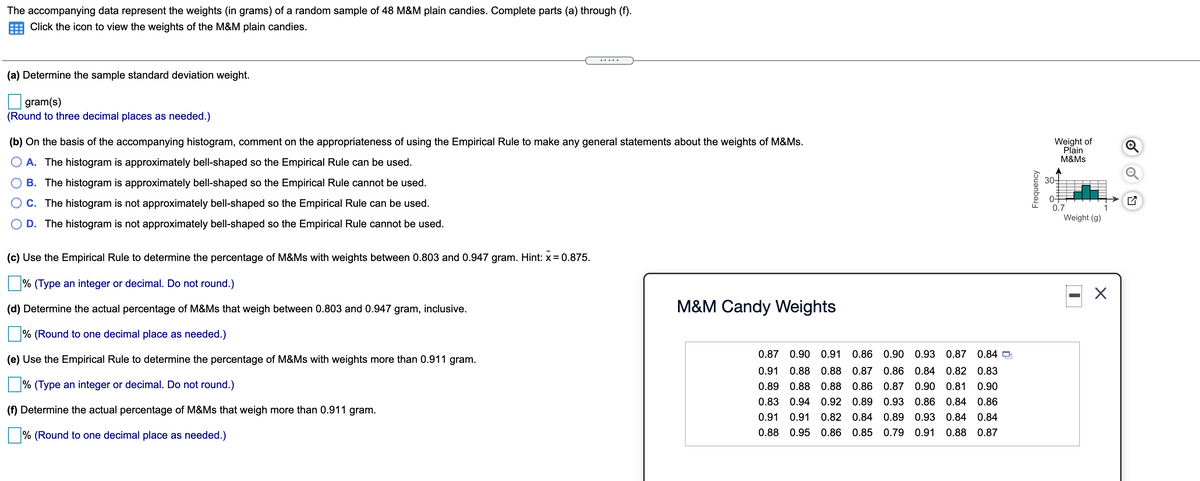The accompanying data represent the weights (in grams) of a random sample of 48 M&M plain candies. Complete parts (a) through (f). Click the icon to view the weights of the M&M plain candies. a) Determine the sample standard deviation weight. gram(s) Round to three decimal places as needed.) (b) On the basis of the accompanying histogram, comment on the appropriateness of using the Empirical Rule to make any general statements about the weights of M&Ms. Weight of Plain M&Ms O A. The histogram is approximately bell-shaped so the Empirical Rule can be used. O B. The histogram is approximately bell-shaped so the Empirical Rule cannot be used. OC. The histogram is not approximately bell-shaped so the Empirical Rule can be used. Weight (g) O D. The histogram is not approximately bell-shaped so the Empirical Rule cannot be used. c) Use the Empirical Rule to determine the percentage of M&Ms with weights between 0.803 and 0.947 gram. Hint: x= 0.875. % (Type an integer or decimal. Do not round.) d) Determine the actual percentage of M&Ms that weigh between 0.803 and 0.947 gram, inclusive. M&M Candy Weights % (Round to one decimal place as needed.) 0.87 0.90 0.91 0.86 0.90 0.93 0.87 0.84 D e) Use the Empirical Rule to determine the percentage of M&Ms with weights more than 0.911 gram. 0.91 0.88 0.88 0.87 0.86 0.84 0.82 0.83 % (Type an integer or decimal. Do not round.) 0.89 0.88 0.88 0.86 0.87 0.90 0.81 0.90 0.83 0.94 0.92 0.89 0.93 0.86 0.84 0.86 ) Determine the actual percentage of M&Ms that weigh more than 0.911 gram. 0.91 0.91 0.82 0.84 0.89 0.93 0.84 0.84 % (Round to one decimal place as needed.) 0.88 0.95 0.86 0.85 0.79 0.91 0.88 0.87
The accompanying data represent the weights (in grams) of a random sample of 48 M&M plain candies. Complete parts (a) through (f). Click the icon to view the weights of the M&M plain candies. a) Determine the sample standard deviation weight. gram(s) Round to three decimal places as needed.) (b) On the basis of the accompanying histogram, comment on the appropriateness of using the Empirical Rule to make any general statements about the weights of M&Ms. Weight of Plain M&Ms O A. The histogram is approximately bell-shaped so the Empirical Rule can be used. O B. The histogram is approximately bell-shaped so the Empirical Rule cannot be used. OC. The histogram is not approximately bell-shaped so the Empirical Rule can be used. Weight (g) O D. The histogram is not approximately bell-shaped so the Empirical Rule cannot be used. c) Use the Empirical Rule to determine the percentage of M&Ms with weights between 0.803 and 0.947 gram. Hint: x= 0.875. % (Type an integer or decimal. Do not round.) d) Determine the actual percentage of M&Ms that weigh between 0.803 and 0.947 gram, inclusive. M&M Candy Weights % (Round to one decimal place as needed.) 0.87 0.90 0.91 0.86 0.90 0.93 0.87 0.84 D e) Use the Empirical Rule to determine the percentage of M&Ms with weights more than 0.911 gram. 0.91 0.88 0.88 0.87 0.86 0.84 0.82 0.83 % (Type an integer or decimal. Do not round.) 0.89 0.88 0.88 0.86 0.87 0.90 0.81 0.90 0.83 0.94 0.92 0.89 0.93 0.86 0.84 0.86 ) Determine the actual percentage of M&Ms that weigh more than 0.911 gram. 0.91 0.91 0.82 0.84 0.89 0.93 0.84 0.84 % (Round to one decimal place as needed.) 0.88 0.95 0.86 0.85 0.79 0.91 0.88 0.87
Glencoe Algebra 1, Student Edition, 9780079039897, 0079039898, 2018
18th Edition
ISBN:9780079039897
Author:Carter
Publisher:Carter
Chapter10: Statistics
Section10.4: Distributions Of Data
Problem 19PFA
Related questions
Question

Transcribed Image Text:The accompanying data represent the weights (in grams) of a random sample of 48 M&M plain candies. Complete parts (a) through (f).
Click the icon to view the weights of the M&M plain candies.
(a) Determine the sample standard deviation weight.
gram(s)
(Round to three decimal places as needed.)
(b) On the basis of the accompanying histogram, comment on the appropriateness of using the Empirical Rule to make any general statements about the weights of M&Ms.
Weight of
Plain
M&Ms
O A. The histogram is approximately bell-shaped so the Empirical Rule can be used.
B. The histogram is approximately bell-shaped so the Empirical Rule cannot be used.
30-
O C. The histogram is not approximately bell-shaped so the Empirical Rule can be used.
0.7
Weight (g)
D. The histogram is not approximately bell-shaped so the Empirical Rule cannot be used.
(c) Use the Empirical Rule to determine the percentage of M&Ms with weights between 0.803 and 0.947 gram. Hint: x= 0.875.
% (Type an integer or decimal. Do not round.)
(d) Determine the actual percentage of M&Ms that weigh between 0.803 and 0.947 gram, inclusive.
M&M Candy Weights
% (Round to one decimal place as needed.)
0.87 0.90 0.91 0.86 0.90 0.93 0.87 0.84 O
(e) Use the Empirical Rule to determine the percentage of M&Ms with weights more than 0.911 gram.
0.91
0.88 0.88 0.87 0.86 0.84 0.82 0.83
% (Type an integer or decimal. Do not round.)
0.89 0.88 0.88 0.86 0.87 0.90 0.81 0.90
0.83 0.94 0.92 0.89 0.93 0.86 0.84 0.86
(f) Determine the actual percentage of M&Ms that weigh more than 0.911 gram.
0.91
0.91 0.82 0.84 0.89
0.93 0.84 0.84
% (Round to one decimal place as needed.)
0.88 0.95
0.86 0.85 0.79 0.91
0.88 0.87
Frequency
Expert Solution
This question has been solved!
Explore an expertly crafted, step-by-step solution for a thorough understanding of key concepts.
This is a popular solution!
Trending now
This is a popular solution!
Step by step
Solved in 4 steps

Recommended textbooks for you

Glencoe Algebra 1, Student Edition, 9780079039897…
Algebra
ISBN:
9780079039897
Author:
Carter
Publisher:
McGraw Hill

Glencoe Algebra 1, Student Edition, 9780079039897…
Algebra
ISBN:
9780079039897
Author:
Carter
Publisher:
McGraw Hill